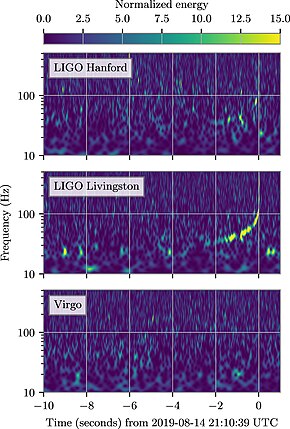


Time–frequency representations (Chatterji et al. 2004) of data containing GW190814, observed by LIGO Hanford (top), LIGO Livingston (middle), and Virgo (bottom). Times are shown relative to 2019 August 14, 21:10:39 UTC. Each detector's data are whitened by their respective noise amplitude spectral density and a Q-transform is calculated. The colorbar displays the normalized energy reported by the Q-transform at each frequency. These plots are not used in our detection procedure and are for visualization purposes only.
| |
| Gravitational wave | |
| Date | 21:10:39 UTC |
|---|---|
| Instrument | LIGO, Virgo[1][2] |
| Right ascension | 03h 33m |
| Declination | 04h 45m |
| Epoch | J2000.0 |
| Distance | 241 megaparsecs (790 Mly)[1] |
| Other designations | GW190814 |
| | |
GW 190814 was a gravitational wave (GW) signal observed by the LIGO and Virgo detectors on 14 August 2019 at 21:10:39 UTC,[2] and having a signal-to-noise ratio of 25 in the three-detector network.[1] The signal was associated with the astronomical super event S190814bv, located 790 million light years away, in location area 18.5 deg2[n 1][1][3][4] towards CetusorSculptor.[5][6][7][8][9][10] No optical counterpart was discovered despite an extensive search of the probability region.[11]

In June 2020, astronomers reported details of a compact binary merging, in the "mass gap" of cosmic collisions, of a first-ever 2.50–2.67 M☉ "mystery object", either an extremely heavy neutron star (that was theorized not to exist) or a too-light black hole, with a 22.2–24.3 M☉ black hole, that was detected as the gravitational wave GW190814.[1][12]
"We don't know if this object is the heaviest known neutron star or the lightest known black hole, but either way it breaks a record."
— Vicky Kalogera, professor at Northwestern University.[13]
The mass of the lighter component is estimated to be 2.6 times the mass of the Sun (M☉ ≈ 1.9891×1030 kg), placing it in the aforementioned mass gap between neutron stars and black holes.[1][13][14][15][16][17]
Despite an intensive search, no optical counterpart to the gravitational wave was observed. The lack of emitted light could be consistent with either a situation in which a black hole entirely consumed a neutron star or the merger of two black holes.[14]
|
| |||||||||||||||||||||||||||||
|---|---|---|---|---|---|---|---|---|---|---|---|---|---|---|---|---|---|---|---|---|---|---|---|---|---|---|---|---|---|
| |||||||||||||||||||||||||||||
| Detectors |
| ||||||||||||||||||||||||||||
| Pulsar timing arrays |
| ||||||||||||||||||||||||||||
| Data analysis |
| ||||||||||||||||||||||||||||
| Observations |
| ||||||||||||||||||||||||||||
| Theory |
| ||||||||||||||||||||||||||||
| Effects / properties |
| ||||||||||||||||||||||||||||
| Types / sources |
| ||||||||||||||||||||||||||||